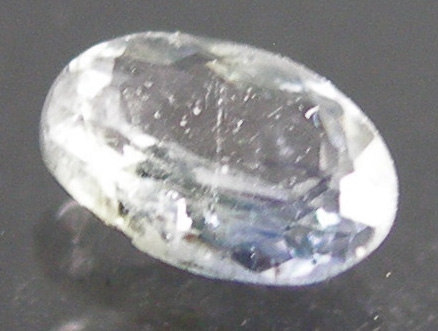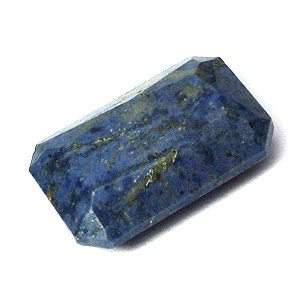Dumortierite

Dumortierite
(From Brazil. Weight: 0.08 carats)
Image © supplied by Woodmansee* Gems
Dumortierite as a mineral occurs commonly in many localities but crystals of Dumortierite are extremely rare and gemstone quality Dumortierite are the rarest.
History & Etymology:
Dumortierite was fist discovered by Eugene Dumortier in the Rhone-Alps of France. Eugene Dumortier was a French paleontologist who found the mineral to occur in metamorphic rocks. The nature and properties of the Dumortierite crystals were later described in 1881. Dumortierite derive their name from the French paleontologist Eugene Dumortier who first discovered them.
Occurrence:
Though the Dumortierite mineral is quite common and occurs in many localities around the world, Dumortierite are extremely rare. The usually massive mass of Dumortierite is fibrous and often granular thus not capable of producing crystals of gem quality crystals of Dumortierite. The faceted gemstones of Dumortierite are extremely rare and often have inclusions and hence are not clear or bright to the eye.
The localities of Dumortierite are located in Sri Lanka, Norway, Italy, Brazil, Austria, Canada, Madagascar, France, Poland, Namibia and Russia. Only the localities in Brazil produce crystals of Dumortierite. Very rarely one can find gemstone quality crystals of Dumortierite in the localities in Brazil.
Properties:
Dumortierite are grandfathered and are composed of the fibrous aluminum boro-silicate. The Dumortierite crystals are hence classified as silicates mineral. Dumortierite display orthorhombic and dipyramidal properties. The Dumortierite crystals occur fibrous and granular masses. Dumortierite also sometimes occur as columnar masses of at least 6 cm size. Twinning is quite common in the Dumortierite crystals. Twinning in the Dumortierite crystals sometimes also produces trillings.
The cleavage on Dumortierite can be distinct and indistinct. However the fracturing on the Dumortierite crystals is fibrous thus making the Dumortierite crystals quite brittle. The Moh’s hardness for the Dumortierite crystals is however between a high 7.0 and 8.5. The Dumortierite crystals are also quite dense measuring 3.3 gm/cm3. Dumortierite are not radioactive and do not display properties of luminescence.
Dumortierite occur in colors ranging from light blue to dark blue, green to greenish blue, pink, brown and violet. The pink, brown and violet crystals of Dumortierite are extremely rare. However masses of pink, brown and violet Dumortierite is quite common. The blue and greenish blue color of Dumortierite often causes many people to confuse the mineral with the popular lapis lazuli. This coloring also allows the Dumortierite gemstones to be used as substitute for lapis lazuli.
The wide variety of colors also produces a wide variety of transparency in the Dumortierite crystals. Hence the Dumortierite crystals range from transparent to translucent. The lack of distinct cleavages causes the luster of the Dumortierite crystals to range from vitreous to dull. The dispersion in the Dumortierite crystals is however quite strong.
Dumortierite are typically found in areas which are rich in aluminum and in aluminum rich metamorphosed rocks. Dumortierite are also found in pegmatitic veins. The Dumortierite mineral is mostly used to manufacture high quality porcelain. However the clear crystals are collected by gemstone experts and these gemstones of Dumortierite command high prices starting at few hundred dollars per carat.

Dumortierite Gemstone
From Peru. 7.00 carat square cut; 15.2 x 10.3 x 4.9mm.
Image supplied by Freakingcat Gems
Back to the Gemstones List home page - over 160 gemstones explored!
Please feel free to link to this page - copy / paste the text below: (click to select)
Privacy Policy | Cookie Policy | GDPR | About This Site / Terms

© gemstoneslist.com 2018


